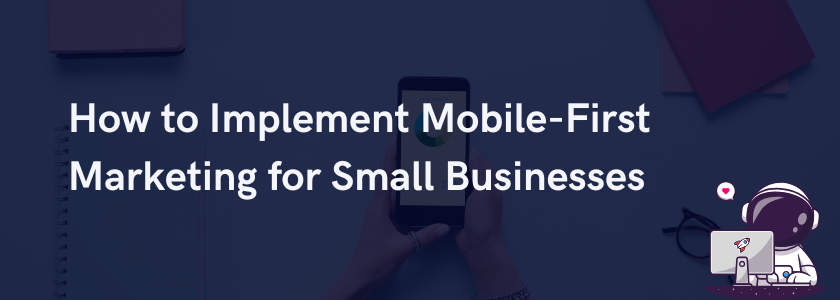Smartphones are now the go-to device for almost everything: browsing, shopping, looking up nearby services, and connecting with brands. For small businesses, this shift isn’t something to ignore. A mobile digital strategy has become the foundation for reaching and keeping customers.
Mobile marketing for small businesses means designing your entire digital presence around mobile users. That includes your website, ads, emails, and social media. With over half of global web traffic coming from mobile devices, these numbers show a clear shift in how people browse, shop, and engage online. When your business aligns with that behavior, you’re better positioned to attract and keep customers.
This guide will help you explore mobile marketing trends for a new business or update your current efforts.
What Is Mobile-First Marketing?
Mobile-first marketing is a strategy that starts by focusing on mobile users before anything else. Instead of shrinking desktop content to fit phones, this approach designs everything specifically for mobile screens from the very beginning.
A strong mobile marketing strategy considers how people behave on smaller screens. It emphasizes fast-loading pages, clean layouts, easy navigation, and a scroll-friendly design. A well-planned mobile digital strategy ensures that your content works seamlessly across all mobile devices.
Your mobile-first content strategy plays a major role here. That means writing short, clear headlines, using compact paragraphs, and sharing videos or images that are optimized for phones. Your goal is to help users get the information they need quickly and clearly.
This method is especially effective when it comes to mobile marketing for small businesses. Local shoppers often search nearby services on their phones when they’re ready to take action. And with the rise of app-based shopping, mobile marketing for ecommerce is more important than ever.
Even if you’re just starting out, mobile marketing for new business efforts can help you build credibility and connect with your target audience.
Why Mobile-First Matters for Small Businesses
Many small business owners still prioritize desktop design, but consumer habits have shifted. Today, people spend more time browsing, shopping, and searching on their phones than on computers.
According to recent mobile marketing facts, an average person spends 4 hours and 37 minutes on their phone every day. That means your potential customers are seeing ads, reading emails, and browsing websites primarily on mobile devices.
Ignoring this shift puts your business at a disadvantage. A mobile marketing strategy helps ensure your website is easy to navigate on a phone, your content is accessible, and your calls-to-action are clear and tappable. This can directly influence how many people engage with your business or make a purchase.
Mobile marketing for small businesses is especially powerful in local settings. Think about someone searching for “coffee near me” or “haircuts in [your city].” If your business isn’t optimized for mobile, you may miss the chance to be seen in those local search results.
For those offering products online, mobile marketing for ecommerce is vital. A well-planned mobile digital strategy can reduce cart abandonment, improve checkout speed, and increase repeat purchases. Clear images, short product descriptions, and one-click purchase options all help mobile shoppers complete their purchases without frustration.
Even if you’re starting from scratch, mobile marketing for new business plans gives you a strong entry point. You don’t need a large budget to launch. A few smart decisions, like investing in responsive design and focusing on mobile-first content strategy, can make a big impact right away.
Core Elements of a Mobile Marketing Strategy
To build a solid mobile marketing strategy, you need to focus on how your digital presence works on phones. It’s more than shrinking things to fit a smaller screen. Each element of your mobile digital strategy should be built for fast access, easy interaction, and smooth navigation.
Here are the key components to focus on:
1. Responsive Website Design
Your website should automatically adjust to fit any screen size. A responsive web design ensures that users don’t have to pinch, zoom, or scroll sideways. This is foundational to mobile-first marketing. It also helps with search rankings, since search engines prioritize mobile-friendly sites.
2. Fast Load Times
Speed plays a huge role in keeping mobile users on your site. If a page takes more than a few seconds to load, most people won’t wait. Your mobile marketing strategy should focus on faster load times by compressing images, minimizing large scripts, and using mobile-first layouts. Regular performance testing helps make sure everything runs smoothly, especially on smaller screens.
3. Clear, Clickable CTAs
On mobile, buttons need to be easy to tap. Your call-to-action should be visible without needing to scroll too far. Avoid placing links too close together, and make sure they work on all devices.
4. Mobile-First Content Strategy
Content for mobile should be concise and focused. Use headers to break up text, add bullet points where needed, and make sure your font size is readable on small screens. Videos and graphics should load quickly and display correctly.
Mobile marketing for ecommerce benefits a lot from this approach. A clear product image, a short description, and a smooth checkout process can increase conversion rates.
5. SMS and Push Notifications
Text messages and mobile alerts are direct ways to reach customers. They can drive traffic to your site, promote special offers, or remind people about abandoned carts. These tools are especially useful in mobile marketing for small businesses with local or time-sensitive deals.
6. Local Mobile SEO
For service-based businesses, showing up in local searches is critical. Keep your Google Business Profile updated, use location-specific keywords, and make sure your address and contact details are easy to find. This supports mobile marketing for new business setups targeting nearby customers.
Each part of your mobile marketing strategy should support the next. A fast website makes your content easier to read. Strong content drives users to take action. And tools like SMS and local search help bring people back.
ALSO READ: Best Free SEO Chrome Extensions
Setting Goals and Choosing the Right Channels
Before launching any mobile-first marketing efforts, it helps to define clear, realistic goals. This step shapes the rest of your mobile marketing strategy and helps you focus your time and budget.
1. Define What Success Looks Like
What do you want mobile users to do? Common goals include:
- Visiting your store or website
- Signing up for your newsletter
- Making a purchase through your mobile site
- Calling your business directly from a search result
Your mobile digital strategy should align with these outcomes. A strong mobile marketing strategy will tie your content, layout, and platform choices to these specific actions.
2. Pick the Right Platforms for Your Audience
Not every platform fits every business. For mobile marketing for small businesses, the most effective channels are usually:
- Facebook and Instagram: Great for building visibility with photos, reels, and stories. These platforms work well with a mobile -first content strategy.
- Google Ads (Search and Display): Helps you show up in mobile searches when users are looking for solutions fast.
- SMS campaigns: Useful for time-sensitive offers and appointment reminders.
- Email marketing: Still effective, but must be formatted correctly for mobile screens.
If you’re in ecommerce, focus on mobile marketing for ecommerce platforms like Instagram Shops or Google Shopping. For those starting out, mobile marketing for new business goals might include social media engagement or local search presence.
3. Tailor Content to Each Platform
Different channels call for different tactics. Visual content grabs attention on social media, while concise messaging makes the biggest impact in SMS. For search ads, clear and relevant messaging performs best. A strong mobile marketing strategy adapts to each format while keeping your brand voice consistent across all platforms.
It also helps to test your efforts regularly. Review what’s working, adjust what isn’t, and keep your content aligned with your mobile-first content strategy. Tracking user behavior and engagement can show you where to spend more time or scale back.
Setting goals and using the right channels make your mobile marketing services more efficient. It ensures that each part of your mobile digital strategy contributes to your larger business objectives.
Tips for Creating a Mobile-First Content Strategy
A mobile-first content strategy involves creating content that performs well on smaller screens, loads quickly, and delivers information clearly and efficiently. It is a critical part of any mobile marketing strategy and supports mobile marketing for small businesses that want to stay competitive in a digital-first world.
Whether you’re managing mobile marketing for ecommerce or creating a digital presence for a local service business, these content tips will help you get it right from the start.
1. Prioritize Clarity and Simplicity
On mobile, people scroll fast and have little patience for complex layouts or long-winded messages. You need to grab attention quickly and communicate your message in just a few lines. That means cutting unnecessary words, using plain language, and highlighting only the most important information.
Clarity improves engagement in mobile marketing for small businesses. It encourages potential customers to keep reading or take the next step, like calling, booking, or buying. A mobile marketing strategy built around clear content will consistently outperform one packed with dense text or cluttered visuals.
2. Use Visuals That Load Quickly
Images and videos are powerful tools, but only if they load fast and display correctly. Slow-loading visuals can frustrate users and lead to high bounce rates. Optimize images for mobile devices by compressing them without sacrificing too much quality. Use file formats like WebP or JPEG for photos and keep animations short and simple.
This is especially important in mobile marketing for ecommerce, where buyers rely on visuals to make decisions. Make sure your product images are zoomable, clear, and taken from multiple angles. In mobile marketing for new business pages, strong visuals also help build trust and leave a positive first impression.
3. Design for Taps, Not Clicks
The way people interact with mobile content is different from how they use desktops. Fingers are less precise than mouse cursors, so your mobile digital strategy must include buttons and links that are easy to tap. They should be large enough, spaced out properly, and positioned in a way that makes sense within the flow of the content.
In mobile marketing for small businesses, this can mean having a “Call Now” button on your homepage, a “Book Appointment” CTA under your services section, or a direct link to your contact form. A well-designed mobile marketing strategy removes friction from the user journey, making it easier for people to convert.
4. Stick to Vertical Layouts
Most mobile users scroll vertically, so your layout should reflect this behavior. Avoid wide rows or side-by-side content that forces users to pinch, zoom, or rotate their phones. Stick to a single column design with vertical stacking that flows naturally as someone swipes down the screen.
This tip also supports mobile marketing for ecommerce where product pages, checkout forms, and category lists should follow a clean top-to-bottom layout. For businesses just starting mobile marketing for new business efforts, this structure makes your site easier to build and more intuitive for visitors.
5. Structure Content with Headings and Bullets
Walls of text don’t work on mobile. People want to skim through content quickly to find what they need. Use subheadings to guide the reader and bullet points to highlight features, benefits, or steps. This makes the content easier to understand and digest, especially when someone is on a tight schedule.
Your mobile marketing strategy should also treat each heading as an opportunity to lead users into action. For example, if you’re offering mobile marketing services, a heading like “Why Local SEO Matters on Mobile” is more effective than a vague “Learn More.” Structuring your content this way improves engagement and drives better results.
6. Consider Context and Timing
Mobile users are often multitasking. They might be walking, waiting in line, or taking a short break. That’s why content needs to match their context. It should be light, direct, and easy to absorb within a few seconds. Use short videos, carousels, or interactive elements that respond quickly without lag.
A smart mobile digital strategy doesn’t just ask what users want to see. It also considers when and where they’re most likely to view it. Mobile marketing for new business launches, for example, can benefit from targeting lunchtime or evening hours when users are more likely to engage.
Timing, layout, and content must all work together to create an experience that feels convenient and relevant.
Mistakes to Avoid in Mobile-First Marketing
Even small mistakes can affect how well your mobile marketing strategy performs. One common issue is failing to test your website across different devices. If your pages don’t load fast or look clean on mobile, users will leave quickly. This is especially important for mobile marketing for ecommerce, where speed and layout can directly impact sales.
Another mistake is skipping local optimization. Mobile marketing for small businesses relies on local search visibility. If your Google Business Profile is outdated or missing, potential customers may not find you. For mobile marketing for new business pages, this detail can help you stand out in a crowded market.
Many businesses also try to reuse desktop content on mobile, which can lead to cluttered designs, tiny text, and confusing layouts. A mobile-first content strategy should include short paragraphs, larger fonts, and tap-friendly buttons that support a clear path to conversion.
When to Work with a Mobile Marketing Services Provider
At some point, handling everything on your own can slow down growth. If your mobile marketing strategy isn’t bringing in results or you’re spending too much time trying to figure things out, it may be time to consider professional support.
A mobile marketing services provider can help create a tailored mobile digital strategy that fits your business goals. This includes designing a mobile-first content strategy, optimizing your website for faster load times, and building mobile campaigns that work across different platforms.
If you find it hard to keep up with mobile trends, feel unsure about your current strategy, or simply want to improve your results, working with a mobile marketing services team can help you move forward with clarity and confidence.
Start Building Your Mobile-First Presence Today
Focusing on a mobile-first content strategy improves how people interact with your brand. It makes your site easier to use, your content more engaging, and your calls to action more effective.
If you’re ready to take your efforts further, our team at Reach Digital can help. We offer mobile marketing services designed for growing businesses that want clear results. From building your mobile-first marketing plan to optimizing campaigns across devices, we’ll work with you to develop a strategy that suits your business.
Learn more about how Reach Digital can support your mobile marketing strategy and help your business grow on mobile. Get started here.





